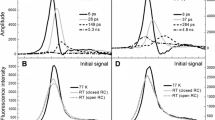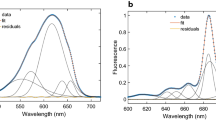Abstract
Monomeric and trimeric Photosystem I core complexes from the cyanobacterium Synechocystis PCC 6803 and LHC-I containing Photosystem I (PS I-200) complexes from spinach have been characterized by steady-state, polarized light spectroscopy at 77 K. The absorption spectra of the monomeric and trimeric core complexes from Synechocystis were remarkably similar, except for the amplitude of a spectral component at long wavelength, which was about twice as large in the trimeric complexes. This spectral component did not contribute significantly to the CD-spectrum. The (77 K) steady-state emission spectra showed prominent peaks at 724 nm (for the Synechocystis core complexes) and at 735 nm (for PS I-200). A comparison of the excitation spectra of the main emission band and the absorption spectra suggested that a significant part of the excitations do not pass the red pigments before being trapped by P-700. Polarized fluorescence excitation spectra of the monomeric and trimeric core complexes revealed a remarkably high anisotropy (∼0.3) above 705 nm. This suggested one or more of the following possibilities: 1) there is one red-most pigment to which all excitations are directed, 2) there are more red-most pigments but with (almost) parallel orientations, 3) there are more red-most pigments, but they are not connected by energy transfer. The high anisotropy above 705 nm of the trimeric complexes indicated that the long-wavelength pigments on different monomers are not connected by energy transfer. In contrary to the Synechocystis core complexes, the anisotropy spectrum of the LHC I containing complexes from spinach was not constant in the region of the long-wavelength pigments, and decreased significantly below 720 nm, the wavelength where the long-wavelength pigments on the core complexes start to absorb. These results suggested that in spinach the long-wavelength pigments on core and LHC-I are connected by energy transfer and have a non-parallel average Qy(0-0) transitions.
Similar content being viewed by others
Abbreviations
- PS:
-
Photosystem
- P:
-
Primary donor
- Chl:
-
chlorophyll
- LHC:
-
light-harvesting complex
- CD:
-
circular dichroism
- LD:
-
linear dichroism
- BisTris:
-
2-[bis(2-hydroxyethyl)amino]-2-hydroxy-methylpropane-1,3-diol
- RC:
-
reaction center
References
Almog O, Shoham G, Michaeli D and Nechustai R (1991) Monomeric and trimeric forms of Photosystem I reaction center of Mastigocladus laminosus: Crystalization and preliminary characterization. Proc Natl Acad Sci USA 88: 5312–5316
Boekema EJ, Dekker JP, vanHeel MG, Rögner M, Saenger W, Witt I and Witt HT (1987) Evidence for a trimeric organization of the Photosystem I complex from the thermophilic cyanobacterium Synechococcus sp. FEBS Lett 217: 283–286
Boekema EJ, Wynn RM and Malkin R (1990) The structure of spinach Photosystem I studied by electron microscopy. Biochim Biophys Acta 1017: 49–56
Böttcher B, Gräber P and Boekema EJ (1992) The threedimensional structure of Photosystem I from the thermophilic cyanobacterium Synechococcus sp. determined by electron microscopy of membrane crystals. Biochim Biophys Acta 1100: 125–136
Ford RC and Holzenburg A (1988) Investigation of the structure of trimeric and monomeric Photosystem I reaction centre complexes. EMBO J 7: 2287–2293
Ford RC, Hefti A and Engel A (1990) Ordered arrays of the Photosystem I reaction centre after reconstitution: Projections and surface reliefs of the complex at 2 nm resolution. EMBO J 9: 3067–3075
Golbeck JH (1987) Structure, function and organization of the Photosystem I reaction center complex. Biochim Biophys Acta 895: 167–204
Haworth P, Watson JL and Arntzen CJ (1983) The detection, isolation and characterization of a light-harvesting complex which is specifically associated with Photosystem I. Biochim Biophys Acta 724: 151–158
Hefti A, Ford RC, Miller M, Cox RP and Engel A (1992) Analysis of the structure of Photosystem I in cyanobacterial thylakoid membranes. FEBS Lett 296: 29–32
Hemelrijk PW, Kwa SLS, vanGrondelle R and Dekker JP (1992) Spectroscopic properties of LHC-II, the main light-harvesting chlorophyll a/b protein complex from chloroplast membranes. Biochim Biophys Acta 1098: 159–166
Hladík J and Sofrová D (1991) Does the trimeric form of the Photosystem I reaction center of cyanobacteria in vivo exist? Photosynth Res 29: 171–175
Holzwarth AR (1991) Excited-state kinetics in chlorophyll systems and its relationship to the functional organization of the photosystems. In: Scheer H (ed) Chlorophylls, pp 1125–1151. CRC Press, Boca, Raton, Florida
Ikegami I and Itoh S (1988) Absorption spectroscopy of P-700-enriched particles isolated from spinach. Is P-700 a dimer of a monomer? Biochim Biophys Acta 934: 39–46
Jia Y, Jean JM, Werst MM, Chan C-K and Fleming GR (1992) Simulations of the temperature dependence of energy transfer in the PS I core antenna. Biophys J 63: 259–273
Kwa SLS, Newell WR, vanGrondelle R and Dekker JP (1992) The reaction center of Photosystem II studied with polarized fluorescence spectroscopy. Biochim Biophys Acta 1099: 193–202
Mukerji I and Sauer K (1989) Temperature-dependent steady-state and picosecond kinetic fluorescence measurements of a Photosystem I preparation from spinach. In: Briggs WH (ed) Photosynthesis, pp 105–122. AR Liss, New York
Mukerji I and Sauer K (1990) A spectroscopic study of the Photosystem I antenna complex. In: Baltscheffsky M (ed) Current Research in Photosynthesis, Vol II, pp 5.321–5.324. Kluwer Academic Publishers, Dordrecht, The Netherlands
Mullet JE, Burke JJ and Arntzen CJ (1980) Chlorophyll proteins of Photosystem I. Plant Physiol 65: 814–822
Newell WR, vanAmerongen H, Barber J and vanGrondelle R (1991) Spectroscopic characterisation of the reaction centre of Photosystem II using polarised light: Evidence for β-carotene excitons in PS II reaction centers. Biochim Biophys Acta 1057: 232–238
Owens TG, Webb SP, Alberte RS, Mets L and Fleming GR (1988) Antenna structure and excitation dynamics in Photosystem I. I. Studies of detergent isolated Photosystem I preparations using time-resolved fluorescence analysis. Biophys J 53: 733–745
Rögner M, Mühlenhoff U, Boekema EJ and Witt HT (1990a) Mono, di- an trimeric PS I reaction center complexes isolated from the thermophilic cyanobacterium Synechococcus sp. Size, shape and activity. Biochim Biophys Acta 1015: 415–424
Rögner M, Nixon PJ and Diner BA (1990b) Purification and characterization of Photosystem I and Photosystem II core complexes from wild-type and phycocyanin-deficient strains of the cyanobacterium Synechocystis PCC 6803. J Biol Chem 265: 6189–6196
Searle GFW, Tamkivi R, vanHoek A and Schaafsma TJ (1988) Temperature dependence of antenna chlorophyll fluorescence kinetics in Photosystem I reaction centre protein. J Chem Soc Faraday Trans II 84: 315–327
Shiozawa JA, Alberte RS and Thornber JP (1980) The P700-chl a-protein. Isolation and characteristics of the complex in higher plants. Arch Biochem Biophys 165: 388–397
Tapie P, Choquet Y, Breton J, Delepelaire P and Wollman F-A (1984) Orientation of Photosystem I pigments. Investigation by low-temperature linear dichroism and polarized fluorescence emission. Biochim Biophys Acta 767: 57–69
VanAmerongen H, Vasmel H and vanGrondelle R (1988) Linear dichroism of chlorosomes from Chloroflexus aurantiacus in compressed gels and electric fields. Biophys J 54: 65–76
VanGrondelle R and Sundström V (1988) Excitation energy transfer in photosynthesis. In: Scheer H and Schneider S (eds) Photosynthetic Light-Harvesting Systems, pp 403–438. Walter de Gruyter, New York
Werst M, Jia Y, Mets L and Fleming GR (1992) Energy transfer and trapping in the Photosystem I core antenna. A temperature study. Biophys J 61: 868–878
Wittmershaus BP, Berns DS and Huang C (1987) Picosecond time-resolved fluorescence from detergent-free Photosystem I particles. Biophys J 52: 829–836
Wittmershaus BP, Woolf VM and Vermaas WFJ (1992) Temperature dependence and polarization of fluorescence from Photosystem I in the cyanobacterium Synechocystis sp. PCC 6803. Photosynth Res 31: 75–87
Wynn RM and Malkin R (1988) Interaction of plastocyanin with Photosystem I: A chemical cross-link study of the polypeptide that binds plastocyanin. Biochemistry 27: 5863–5869
Author information
Authors and Affiliations
Rights and permissions
About this article
Cite this article
van der Lee, J., Bald, D., Kwa, S.L.S. et al. Steady-state polarized light spectroscopy of isolated Photosystem I complexes. Photosynth Res 35, 311–321 (1993). https://doi.org/10.1007/BF00016562
Received:
Accepted:
Issue Date:
DOI: https://doi.org/10.1007/BF00016562




